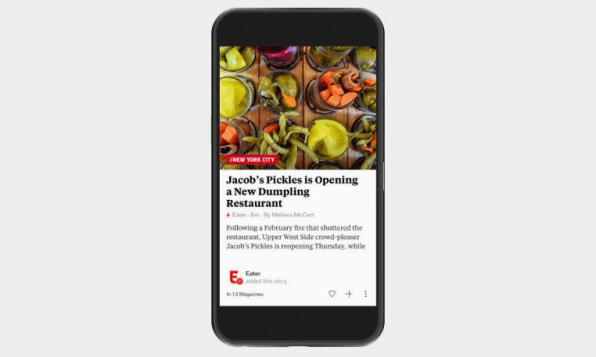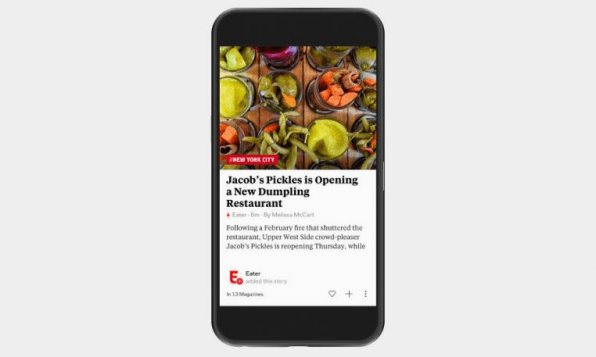
10 Oct Flipboard Just Introduced A Seal Of Approval For Mobile-Friendly Sites
For years, Flipboard has worked closely with major media companies to beautify and monetize their content within its magazine-like aggregation app, which started out on the iPad but is now primarily used on smartphones. That’s been great for those publishers (including, full disclosure, Fast Company) and the people who consume their work.
But on Flipboard as in the world in general, much of the most worthwhile content is created by small outfits, not giants. And there are far too many of them for Flipboard’s big-company collaboration to scale up. So the company is introducing some new self-serve tools that it can roll out to a far larger cohort of publishers. Even tiny media brands will be able to use an RSS feed to power a Flipboard magazine–allowing them, for the first time, to get articles onto Flipboard without any human intervention.
Flipboard isn’t just providing publishers with new capabilities; it’s also asking something of them. The whole idea of Flipboard is to bring an inviting, professional sheen to mobile content–much of which has historically felt like it was designed for desktop PCs and then crammed onto a small screen, where ads and pop-ups can be even more intrusive. Since Flipboard can’t work closely with thousands of publishers to customize their work for Flipboard, it wants to encourage them to be self-sufficient when it comes to mobile-friendly design.
In a way, what the company is doing is the flip side of Google’s Accelerated Mobile Pages and Facebook’s Instant Articles, both of which provide platforms designed to let content render on mobile devices as quickly as possible. Instead of building such a platform and asking publishers to use it, Flipboard is trying to give them incentives to make their own publishing systems efficient and user-centric.

A big part of that incentive is the “RED Bolt,” a little lightning-bolt icon that Flipboard will display next to stories that meet its standard for mobile-friendly content. (It’s red, but RED officially stands for “Reader Enhanced Display.”) The company will also give such articles–including ones from existing mass-media partners such as the New York Times and Fast Company as well as smaller outlets–a bump in the algorithms that determine which items Flipboard users see in their feeds, thereby exposing them to more readers.
The RED Bolt icon, says Flipboard cofounder and CEO Mike McCue, is a sign that an article “is going to load quickly, it’s going be be really respectful of reader experience when it comes to advertising, and it’s going to be optimized for a mobile experience.” He told me that smaller, more niche publishers are already key to Flipboard’s appeal, particularly as the company has increasingly used algorithms to expose articles to the readers whose “interest graphs” suggest they’ll be interested in them. (One example he gave from his own personal passions: Visual Wilderness, a site about nature photography.) With its new announcements, the company wants to help such brands raise their Flipboard visibility even further.
Related: Flipboard’s Quest To Save Online Publishing–And Itself
Promoting The Good, Barring The Bad
Flipboard will use a combination of technology and humans to determine which publishers meet the RED Bolt standards; it says that thousands of creators will come on board this year, and that the process will be fully automated in 2018. The company will also lightly curate the list of publishers who get access to new tools such as RSS publishing. “If it’s hate speech, it’s not going to be accepted,” says McCue. “Or if it’s clearly spam.”
Though Flipboard isn’t an 800-pound-gorilla peer of Google, Facebook, or Twitter in terms of the sheer enormity of traffic it sends to websites, it ranks high among the next group of traffic sources after those behemoths, especially on mobile devices. That gives the company a fair amount of influence in the media business. According to McCue, he’s trying to use that power for the good of the publishers, not just Flipboard.
Building viable online media businesses remains a most challenging proposition. McCue, who worked at Netscape in the 1990s when the web first became a major medium, says that he’s “worried” about publishers chasing after short-term revenue that might damage their long-term viability, such as ads so pesky that they drive away readers. “It creates less of a willingness for consumers to use the mobile web, and then they tend to stay in environments like Facebook more,” he argues. “I believe this is an existential threat for publishers.”
Publishers who invest effort in getting the RED Bolt imprimatur will reap benefits on their own sites, not just within Flipboard, says McCue. “When they optimize for Flipboard, what they’re optimizing for is the mobile web, because it is the mobile web. It’s important for publishers to be able to thrive on the mobile web and not be dependent on any one platform.”
Flipboard’s existing arrangements with major media companies extend to helping them sell advertising that appears in its app. Its new self-service tools don’t include anything along those lines, which means that smaller publishers will be on their own when it comes to figuring out how to sell and integrate ads–and do it in a way that doesn’t turn off readers. Thinking about the monetization side of the conundrum, McCue says, is on his company’s to-do list.
Source: Fast Company




Sorry, the comment form is closed at this time.